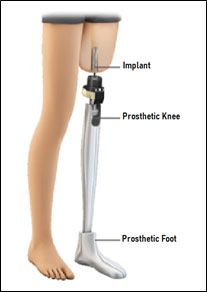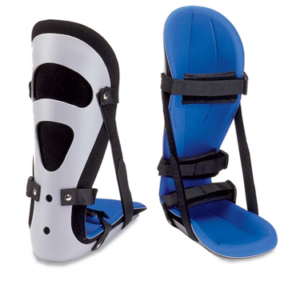Osseointegration
What is Osseointegration?

Figure 1: Diagram demonstrating osseointegration implant within bone and exiting limb.
Osseointegration is a surgery that inserts a metal implant into a bone. Osseointegration was first introduced in the 1950s and today is commonplace in dental implants, hip and knee replacements, and newly with prosthetic limbs. With amputees, the implant is fixed within the bone and extends out of the end of the patient’s limb. This is demonstrated in Figure 1 to the right. The surgical process varies depending on which type of implant is used.
Prosthetic components can be attached to the end of the implant that is outside at the end of the limb. This is demonstrated in Figure 2, left below. The components are attached to the implant instead of a socket. Osseointegration eliminates the need and use of prosthetic sockets.
What Are the Benefits of Osseointegration?
Osseointegration has been demonstrated to result in dramatic improvements for patients. Since the prosthetic componentry is connected directly through the patient’s bone, the patient experiences osseoperception. Osseoperception is the ability to perceive where the limb is in space. This is possible due to the nerves in the surrounding tissues providing feedback information on where the bone, and connected prosthesis, are. With an osseointegrated prosthesis, the prosthetic components move with the bone, instead of with slight delay present in even the best fitting sockets. Patients both feel better and perform better with osseointegration. Patients report they feel more comfortable and confident. They feel more comfortable sitting with their prosthesis on and can take their prosthesis on and off much more quickly. Performance outcomes improve in that patients have fewer deviations from a natural gait. Patients walk more quickly and are expending less energy to do so, measured by oxygen requirement. Due to all these reasons, there is also an increase in the amount of time throughout the day that a patient wears their prosthesis.

Figure 2: Diagram demonstrating prosthetic components attached to an osseointegration implant.
Am I a Candidate for Osseointegration?





